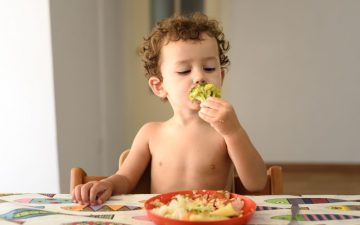
For first-time parents, it isn’t easy to know when is the right time to introduce solid food to their babies. In addition, choosing which food to give and how to present it to their baby is just as difficult.
Babies are messy eaters, but that’s natural. Also, their playing with food allows them to develop their motor skills. And with you around, babies develop their social skills by interacting and communicating with you during eating. Thus, when they start eating solids, they must have the best baby bowls and spoons to help them eat and learn about new flavors.
We want to help make your baby’s first time eating solid food as great as possible, so here is a short guide on how to start your infant on solid foods.
When Can Babies Start Eating Solid Foods?
Parents are advised to introduce their babies to new food besides milk when they reach six months. The Dietary Guidelines for Americans and the American Academy of Pediatrics don’t recommend starting them younger than that.
You can also observe your baby’s behavior to see signs that they are ready for solid food. For example, when they can sit up by themselves and open their mouths when you offer them food, your baby might be prepared to try new food. They might also try to grab objects and put them in their mouth. Finally, they will swallow food instead of playing with it or pushing it away.
10 Tips on Starting Your Baby on Solid Foods
-
Start with a Puree
To make a puree, all you need is a raw ingredient such as fruits and vegetables and a food processor or a baby food mixer. But before you follow recipes, make sure to introduce your baby to a small amount of the raw ingredients first. You don’t want to make a large amount of healthy puree only for your baby to spit it out because they don’t like the taste or are unfamiliar with it.
Once you know what fruits and vegetables your child likes, you can now start the puree party. Lightly cook the ingredients before putting them in the food processor. Then, make sure it doesn’t have any solids anymore.
Note that homemade baby food puree has a shelf life of no more than 48 hours inside your refrigerator. To be safe, label the jar or container with the date you made the food and the date you need to take the container out. Seal the jars tightly to avoid bacterial growth.
-
Graduate to Bite-Size Food
Once your baby can swallow puree food, you can introduce them to fruits or foods that they can grab and put in their mouth.
First, chop some solid food such as pasta, baby snacks, and fruits. Next, train their mind and their little hands using non-slippery food. Make sure the size is not too big to be a choking hazard and not too small for them to pick up. Encourage and praise your toddler every time they successfully put food in their mouth and eat it.
-
Introduce Them to a Baby Spoon
For your child to start using baby-safe utensils, you must feed them using a feeding spoon first. They will then associate the utensil as a tool for eating.
After a while, try to give them the spoon with some puree. Then, leave bite-size food (that they usually eat) in a feeding bowl so that they can practice scooping.

-
Choose the Right Size of Bowl and Spoon for Your Baby’s Age
Babies can’t just use any bowl or spoon. They need to use the ones made for their age and size.
The best feeding bowls and spoons for babies are made from nonbreakable materials such as food-grade silicone. They must also have a safety feature, such as suction on the bottom.
-
Check If the Utensils Are Made from Food-Safe Materials
The best baby bowl and spoon set is made with food-grade silicone or baby-safe plastic and is free from microplastics, harmful chemicals, and dangerous toxins. It should also be
- BPA free,
- PVC free,
- lead-free, and
- phthalates-free.
Their small bodies cannot fight the toxins coming from bacteria-filled utensils such as a metal spoon. So, as an additional safety measure, check the materials used to make your baby’s items.
-
Thoroughly Clean Baby Utensils Before and After Use
Make it a habit to wash your baby’s spoon and bowls before and after using them. Silicone utensils made for babies are easy to clean using dish soap and are dishwasher-safe. After washing, store them in a clean space to keep them bacteria-free for the next mealtime.
-
Beware of Choking Hazards
When your baby has found the joy of eating and putting things in their mouth, keep an eye on them when it’s not feeding time. As playful as they are, they may grab the nearest small item, think it’s food, and try to put it in their mouth. Many choking hazards lie around your house, so be sure to clean the house and put away small objects regularly.

-
Take Time to Enjoy Feeding Your Baby
Feeding is an important milestone in your baby’s life, and you should keep memories of their first bites. These are the times when they try to eat using a spoon but miss, when baby food is all over their bibs, cheeks, and floor—everywhere else except actually inside their mouth.
They are newbies to eating, but they are trying. Soon enough, they will get the hang of it, just like we did. To make this experience as mess-free as possible, choose baby feeding bowls with suction at the bottom so that your baby won’t knock down the whole serving.
-
Don’t Overfeed Your Baby
While it’s fun to see them stuff their face with food, only give them a controlled amount so that they won’t overfeed themselves. Remember that children’s stomachs are still developing and not equipped for a large amount of food.
A big sign that you have overfed your baby is when they start to burp, vomit, or cry. At the first sight of discomfort from your child, stop feeding right away.
-
Consistency Is Key
You need to do a task consistently when training to master it. For example, if you have started introducing solid food to your baby, continue doing so until they no longer like baby food. Let them practice eating by themselves often, if not every meal. It helps them develop their motor skills and food preferences and practice independence during mealtime.
Find the Best Baby Bowls and Other Child-Safe Utensils on Ashtonbee
When your baby turns six months old, try offering them some small pieces of soft fruits or vegetables or a spoonful of the puree version. When they chew and swallow it, they are ready to eat solid food as their main diet. Remember to start small and explore different tastes and textures to know your baby’s preference.
Along with knowing which food is best for your baby, match yummy food with baby-safe utensils. Your child should enjoy their new experiences, and you parents shouldn’t worry about breakable bowls made from toxic plastic materials.
You have to make so many decisions in the first few years of your child’s youth. One decision that you should not take lightly is finding the best baby feeding bowls and spoons to use for feeding time with your little one. The right eating equipment can make all the difference in how much your child will enjoy their food experience, regardless of whether they’re being fed by hand or from a dish.
That’s why we recommend Ashtoonbee bowls and spoons: they’re ergonomically designed specifically for babies, making them perfect for both beginners learning about solid foods as well as more experienced eaters who are on their way to being fully independent on the dining table.
What are you waiting for? Get the best items for your baby from Ashtonbee today!



